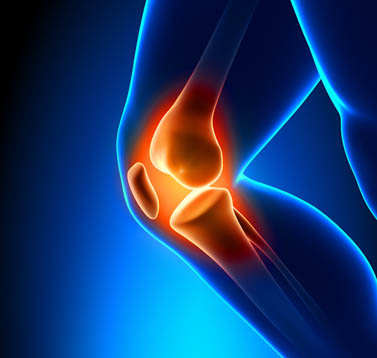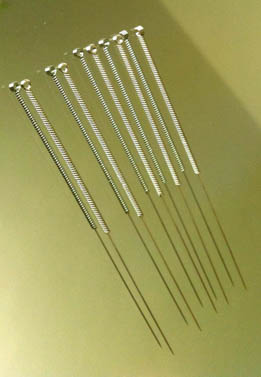
Acupuncture combined with herbs is effective for the relief of knee osteoarthritis pain. Shanghai University of Traditional Chinese Medicine (TCM) researchers conducted a controlled trial and concluded that acupuncture with herbs is both safe and effective. No harmful side effects resulted from the treatment regimen and patients demonstrated significant improvements. The researchers document significant reductions in knee pain with concommitant joint function improvement.
The researchers conducted a highly controlled experiment wherein acupuncture point prescriptions were standardized to a set of specific acupuncture points with predetermined manual acupuncture stimulation procedures. This protocolized approach to treatment eliminates variables from the clinical trial and is often employed in modern research. This varies somewhat from standards of clinical care in that licensed acupuncturists may customize an acupuncture point prescription based on differential diagnostics.
Two acupuncture protocols were compared between treatment groups. One group received acupuncture with herbs in what was termed the Shi treatment procedure. The other protocol of care employed only a standard set of acupuncture points without the use of herbal medicine. The researchers cited Li et al. noting that acupuncture and TCM approaches to patient care for knee osteoarthritis are increasing in common usage and produce significant positive patient outcomes. This experiments tests and confirms the patient outcome aspect of Li et al.
The researchers detailed the acupuncture point procedures and the TCM theory underlying the protocols of care. According to TCM principles, knee osteoarthritis is related to an imbalance in the tendons and bones. This is due, in part, to deficiencies of liver blood and kidney qi. In TCM, the liver is responsible for nourishing the tendons. The kidneys strengthen the bones. In biomedical terms, internal organ insufficiencies lead to the body’s inability to deliver nutrients necessary to maintain the tendons and bones.
The Shi acupuncture with herbs technique outperformed the acupuncture only group. The Shi approach to care focuses on pain relief through the regulation of acupuncture channels. The treatment principle is to produce long-term reductions in cartilage surface friction and soft tissue adhesions. Combined with the herbal formula Yi Shen Juan Bi, in pill form, the treatment is geared towards the reduction of symptoms and the root causes knee osteoarthritis. The researchers document that the Shi approach to care scored significant improvements both in pain reduction and knee joint motion restoration.
VAS (Visual Analog Score) and WOMAC (Western Ontario and McMaster Universities Osteoarthritis Index) scores confirmed the results. WOMAC is an assessment used for hip or knee osteoarthritis pain, stiffness, and physical ability. It consists of 24 separate evaluations including pain assessments of walking, stair climbing, bed rest, sitting, lying, and standing. Stiffness is evaluated upon first walking and then later in the day. Physical functions are evaluated based on 17 criteria including: stairs, sitting, standing, bending, walking, shopping, getting into and out of a car, dressing and undressing socks, lying in bed, getting out of bed, household duties, and other daily living activities. Both VAS and WOMAC scores demonstrate that acupuncture is effective for the treatment of knee osteoarthritis. 
The Shi approach to acupuncture needling employs both local and distal acupuncture points. The Shi acupuncture protocol included the following primary acupuncture points:
- GB34, Yanglingquan
- SP9, Yinlingquan
- ST36, Zusanli
- MN-LE-16, Xiyan
- BL60, Kunlun
- GB39, Xuanzhong
- SP6, Sanyinjiao
Patients rested in a supine position and the knees were supported at a 90 degree angle. Acupuncture needling was inserted to a depth of 10 to 25 mm with mild reinforcing and reducing manual acupuncture techniques combined with twisting. The acupuncture needles were 2.5 inches long and made of stainless steel. Acupuncture needling was applied twice per week and three weeks comprised one course of care.
Patients ingested Yi Shen Juan Bi pills at a rate of three times per day for three weeks to comprise one course of care. The inclusion of this herbal formula is consistent with modern findings. Zhao et al. tested the formula’s efficacy in a lab experiment for the treatment for another type of arthritis, rheumatoid arthritis. Zhao et al. note that “the experimental results demonstrate the protective effect of YJB (Yi Shen Juan Bi Pill) on the TCM kidney deficiency pattern induced by androgen deficiency in CIA (collagen induced arthritis) rats and support that YJB should be used for the clinical treatment of RA (rheumatoid arthritis) with TCM kidney deficiency pattern.”
According to TCM principles, Yi Shen Juan Bi pills have four primary functions. The herbs invigorate blood circulation, transform blood stasis, expel pathogens, and unblock collaterals. The herbal formula, translated as the augment the kidneys and remove painful obstruction pills, contains the following ingredients:
- Shu Di Huang
- Dang Gui
- Yin Yang Huo
- Lu Xian Cao
- Quan Xie
- Wu Gong
- Wu Shao She
- Fang Feng
- Tu Bie Chong
- Jiang Can
- Jiu Qiang Lang
- Ji Xue Teng
- Lao Guan Cao
- Xun Gu Feng
- Hu Zhang
A separate group received only acupuncture at the following acupoints:
- MN-LE-16, Xiyan
- GB34, Yanglingquan
- SP10, Xuehai
- Ahshi points
Stimulation of the needles was similar to that of the Shi acupuncture group. The rate and duration of treatment was identical. However, the Shi acupuncture group that also received herbal medicine significantly outperformed the standalone acupuncture group.
The findings confirm the research of Karner et al. whose research team concluded that acupuncture significantly reduces knee pain and increases mobility for patients with osteoarthritis. In the randomized-controlled double-blinded study, sham acupuncture achieved a patient pain reduction rate in 48%, modern acupuncture achieved a 64% rate, and classical acupuncture achieved a 73% pain reduction rate. Sham acupuncture did not improve knee mobility but modern and classical acupuncture made significant improvements. The researchers concluded that there is “a specific effect of acupuncture in knee mobility.” The researchers also note, “With respect to knee motility, individualised classical acupuncture achieved twice the effect of semistandardised modern acupuncture.”
The modern acupuncture approach to care involved a protocol consisting of the following acupuncture points: ST36, ST34, EX32, SP9, SP10, SP6, GB34, LI4. The classical acupuncture approach to care was based on differential diagnostics per each patient. The researchers note, “This suggests a considerable specific effect of acupuncture in objective knee flexibility, an effect that appears to be method-specific as well… we observed a rapid improvement of knee flexibility immediately after classical acupuncture, which was twice the effect observed after modern acupuncture and absent after non-specific needling.”
Cao et al. conducted an extensive meta-analysis of acupuncture for the treatment of knee osteoarthritis and concluded that true acupuncture is more effective than both sham acupuncture and biomedicine for the treatment of knee pain. The meta-analysis of 14 random controlled clinical trials involving 3,835 patients concludes, “Acupuncture provided significantly better relief from knee osteoarthritis pain and a larger improvement in function than sham acupuncture, standard care treatment, or waiting for further treatment.” The study notes that acupuncture for the treatment of knee osteoarthritis is “better at relieving pain and restoring function” than both standard biomedical care and sham acupuncture.
References:
Hong, H. P., Wang, T., Xie, Y., Wei, X. E., Wang, J. L., Cao, Y. L. & Zhan, H. S. (2015). Combination therapy of Shi’s acupuncture therapy and oral application of Yishen Juanbi Wan for the treatment of knee osteoarthritis. The Journal of Traditional Chinese Orthopedics and Traumatology. 27(5).
Bannuru RR, Schmid CH, Kent DM, et al. (2015). Comparative effectiveness of pharmacologic interventions for knee osteoarthritis: a systematic review and network meta-analysis. Ann Intern Med. 162(1): 46-54.
Li, X. L., Chen, X. Y. & Jin, N. L. (2012). Clinical Comparison between Acupuncture and Helium-neon Laser Treatment for Knee Osteoarthritis. Shanghai Journal of Acupuncture. 31(11): 829-830.
Zhao, Hongyan, Jian Li, Xiaojuan He, Cheng Lu, Cheng Xiao, Xuyan Niu, Ning Zhao, Dahong Ju, and Aiping Lu. "The protective effect of Yi Shen Juan Bi Pill in arthritic rats with castration-induced kidney deficiency." Evidence-Based Complementary and Alternative Medicine 2012 (2012).
Max Karner, Frank Brazkiewicz, Andrew Remppis, et al., “Objectifying Specific and Nonspecific Effects of Acupuncture: A Double-Blinded Randomised Trial in Osteoarthritis of the Knee,” Evidence-Based Complementary and Alternative Medicine, vol. 2013, Article ID 427265, 7 pages, 2013. doi:10.1155/2013/427265
Sau. Med J. 2012 May;33(5):526-32. Needle acupuncture for osteoarthritis of the knee. A systematic review and updated meta-analysis. Cao L, Zhang XL, Gao YS, Jiang Y. Department of Orthopedic Surgery, Shanghai Sixth People's Hospital, Shanghai Jiaotong University, Shanghai, China.

